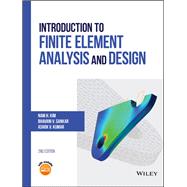Introduces the basic concepts of FEM in an easy-to-use format so that students and professionals can use the method efficiently and interpret results properly
Finite element method (FEM) is a powerful tool for solving engineering problems both in solid structural mechanics and fluid mechanics. This book presents all of the theoretical aspects of FEM that students of engineering will need. It eliminates overlong math equations in favour of basic concepts, and reviews of the mathematics and mechanics of materials in order to illustrate the concepts of FEM. It introduces these concepts by including examples using six different commercial programs online.
The all-new, second edition of Introduction to Finite Element Analysis and Design provides many more exercise problems than the first edition. It includes a significant amount of material in modelling issues by using several practical examples from engineering applications. The book features new coverage of buckling of beams and frames and extends heat transfer analyses from 1D (in the previous edition) to 2D. It also covers 3D solid element and its application, as well as 2D. Additionally, readers will find an increase in coverage of finite element analysis of dynamic problems. There is also a companion website with examples that are concurrent with the most recent version of the commercial programs.
- Offers elaborate explanations of basic finite element procedures
- Delivers clear explanations of the capabilities and limitations of finite element analysis
- Includes application examples and tutorials for commercial finite element software, such as MATLAB, ANSYS, ABAQUS and NASTRAN
- Provides numerous examples and exercise problems
- Comes with a complete solution manual and results of several engineering design projects






